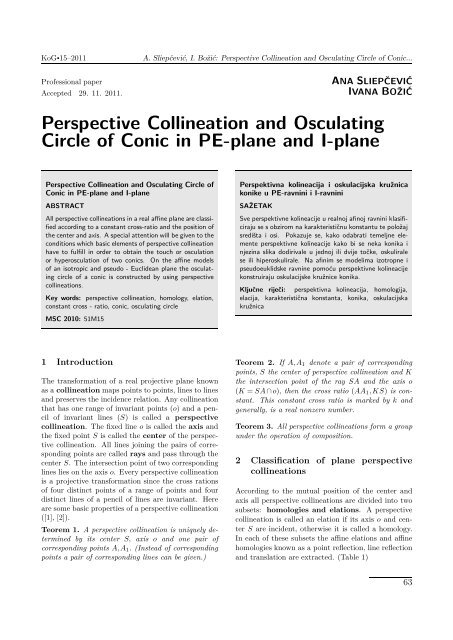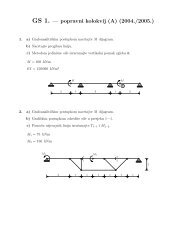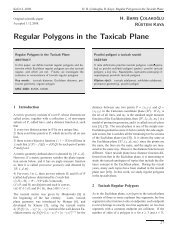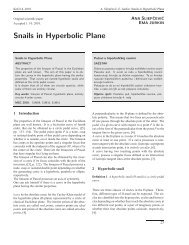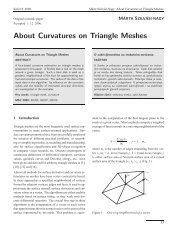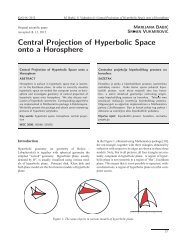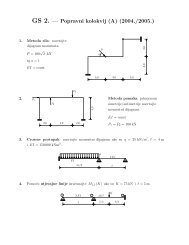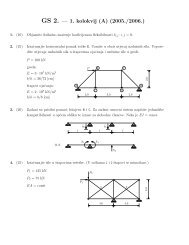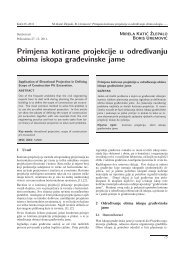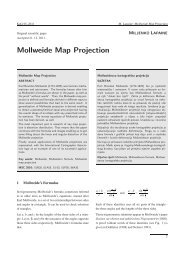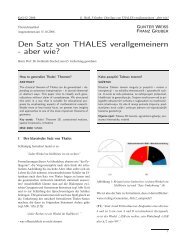Perspective Collineation and Osculating Circle of Conic in PE-plane ...
Perspective Collineation and Osculating Circle of Conic in PE-plane ...
Perspective Collineation and Osculating Circle of Conic in PE-plane ...
Create successful ePaper yourself
Turn your PDF publications into a flip-book with our unique Google optimized e-Paper software.
KoG • 15–2011<br />
Pr<strong>of</strong>essional paper<br />
Accepted 29. 11. 2011.<br />
A. Sliepčević, I. Božić: <strong>Perspective</strong> <strong>Coll<strong>in</strong>eation</strong> <strong>and</strong> <strong>Osculat<strong>in</strong>g</strong> <strong>Circle</strong> <strong>of</strong> <strong>Conic</strong>...<br />
ANA SLIEPČEVIĆ<br />
IVANA BOŽIĆ<br />
<strong>Perspective</strong> <strong>Coll<strong>in</strong>eation</strong> <strong>and</strong> <strong>Osculat<strong>in</strong>g</strong><br />
<strong>Circle</strong> <strong>of</strong> <strong>Conic</strong> <strong>in</strong> <strong>PE</strong>-<strong>plane</strong> <strong>and</strong> I-<strong>plane</strong><br />
<strong>Perspective</strong> <strong>Coll<strong>in</strong>eation</strong> <strong>and</strong> <strong>Osculat<strong>in</strong>g</strong> <strong>Circle</strong> <strong>of</strong><br />
<strong>Conic</strong> <strong>in</strong> <strong>PE</strong>-<strong>plane</strong> <strong>and</strong> I-<strong>plane</strong><br />
ABSTRACT<br />
All perspective coll<strong>in</strong>eations <strong>in</strong> a real aff<strong>in</strong>e <strong>plane</strong> are classified<br />
accord<strong>in</strong>g to a constant cross-ratio <strong>and</strong> the position <strong>of</strong><br />
the center <strong>and</strong> axis. A special attention will be given to the<br />
conditions which basic elements <strong>of</strong> perspective coll<strong>in</strong>eation<br />
have to fulfill <strong>in</strong> order to obta<strong>in</strong> the touch or osculation<br />
or hyperosculation <strong>of</strong> two conics. On the aff<strong>in</strong>e models<br />
<strong>of</strong> an isotropic <strong>and</strong> pseudo - Euclidean <strong>plane</strong> the osculat<strong>in</strong>g<br />
circle <strong>of</strong> a conic is constructed by us<strong>in</strong>g perspective<br />
coll<strong>in</strong>eations.<br />
Key words: perspective coll<strong>in</strong>eation, homology, elation,<br />
constant cross - ratio, conic, osculat<strong>in</strong>g circle<br />
MSC 2010: 51M15<br />
Perspektivna kol<strong>in</strong>eacija i oskulacijska kružnica<br />
konike u <strong>PE</strong>-ravn<strong>in</strong>i i I-ravn<strong>in</strong>i<br />
SAŽETAK<br />
Sve perspektivne kol<strong>in</strong>eacije u realnoj af<strong>in</strong>oj ravn<strong>in</strong>i klasificiraju<br />
se s obzirom na karakterističnu konstantu te položaj<br />
središta i osi. Pokazuje se, kako odabrati temeljne elemente<br />
perspektivne kol<strong>in</strong>eacije kako bi se neka konika i<br />
njez<strong>in</strong>a slika dodirivale u jednoj ili dvije točke, oskulirale<br />
se ili hiperoskulirale. Na af<strong>in</strong>im se modelima izotropne i<br />
pseudoeuklidske ravn<strong>in</strong>e pomoću perspektivne kol<strong>in</strong>eacije<br />
konstruiraju oskulacijske kružnice konika.<br />
Ključne riječi: perspektivna kol<strong>in</strong>eacija, homologija,<br />
elacija, karakteristična konstanta, konika, oskulacijska<br />
kružnica<br />
1 Introduction<br />
The transformation <strong>of</strong> a real projective <strong>plane</strong> known<br />
as a coll<strong>in</strong>eation maps po<strong>in</strong>ts to po<strong>in</strong>ts, l<strong>in</strong>es to l<strong>in</strong>es<br />
<strong>and</strong> preserves the <strong>in</strong>cidence relation. Any coll<strong>in</strong>eation<br />
that has one range <strong>of</strong> <strong>in</strong>variant po<strong>in</strong>ts (o) <strong>and</strong> a pencil<br />
<strong>of</strong> <strong>in</strong>variant l<strong>in</strong>es (S) is called a perspective<br />
coll<strong>in</strong>eation. The fixed l<strong>in</strong>e o is called the axis <strong>and</strong><br />
the fixed po<strong>in</strong>t S is called the center <strong>of</strong> the perspective<br />
coll<strong>in</strong>eation. All l<strong>in</strong>es jo<strong>in</strong><strong>in</strong>g the pairs <strong>of</strong> correspond<strong>in</strong>g<br />
po<strong>in</strong>ts are called rays <strong>and</strong> pass through the<br />
center S. The <strong>in</strong>tersection po<strong>in</strong>t <strong>of</strong> two correspond<strong>in</strong>g<br />
l<strong>in</strong>es lies on the axis o. Every perspective coll<strong>in</strong>eation<br />
is a projective transformation s<strong>in</strong>ce the cross rations<br />
<strong>of</strong> four dist<strong>in</strong>ct po<strong>in</strong>ts <strong>of</strong> a range <strong>of</strong> po<strong>in</strong>ts <strong>and</strong> four<br />
dist<strong>in</strong>ct l<strong>in</strong>es <strong>of</strong> a pencil <strong>of</strong> l<strong>in</strong>es are <strong>in</strong>variant. Here<br />
are some basic properties <strong>of</strong> a perspective coll<strong>in</strong>eation<br />
([1], [2]).<br />
Teorem 1. A perspective coll<strong>in</strong>eation is uniquely determ<strong>in</strong>ed<br />
by its center S, axis o <strong>and</strong> one pair <strong>of</strong><br />
correspond<strong>in</strong>g po<strong>in</strong>ts A,A 1 . (Instead <strong>of</strong> correspond<strong>in</strong>g<br />
po<strong>in</strong>ts a pair <strong>of</strong> correspond<strong>in</strong>g l<strong>in</strong>es can be given.)<br />
Teorem 2. If A,A 1 denote a pair <strong>of</strong> correspond<strong>in</strong>g<br />
po<strong>in</strong>ts, S the center <strong>of</strong> perspective coll<strong>in</strong>eation <strong>and</strong> K<br />
the <strong>in</strong>tersection po<strong>in</strong>t <strong>of</strong> the ray SA <strong>and</strong> the axis o<br />
(K = SA ∩ o), then the cross ratio (AA 1 ,KS) is constant.<br />
This constant cross ratio is marked by k <strong>and</strong><br />
generally, is a real nonzero number.<br />
Teorem 3. All perspective coll<strong>in</strong>eations form a group<br />
under the operation <strong>of</strong> composition.<br />
2 Classification <strong>of</strong> <strong>plane</strong> perspective<br />
coll<strong>in</strong>eations<br />
Accord<strong>in</strong>g to the mutual position <strong>of</strong> the center <strong>and</strong><br />
axis all perspective coll<strong>in</strong>eations are divided <strong>in</strong>to two<br />
subsets: homologies <strong>and</strong> elations. A perspective<br />
coll<strong>in</strong>eation is called an elation if its axis o <strong>and</strong> center<br />
S are <strong>in</strong>cident, otherwise it is called a homology.<br />
In each <strong>of</strong> these subsets the aff<strong>in</strong>e elations <strong>and</strong> aff<strong>in</strong>e<br />
homologies known as a po<strong>in</strong>t reflection, l<strong>in</strong>e reflection<br />
<strong>and</strong> translation are extracted. (Table 1)<br />
63
KoG • 15–2011<br />
A. Sliepčević, I. Božić: <strong>Perspective</strong> <strong>Coll<strong>in</strong>eation</strong> <strong>and</strong> <strong>Osculat<strong>in</strong>g</strong> <strong>Circle</strong> <strong>of</strong> <strong>Conic</strong>...<br />
(AA ;KS) = k ∈ R \ {0}<br />
1<br />
A 1<br />
A<br />
K<br />
S<br />
o<br />
HOMOLOGIES<br />
S∉ o ; k ≠1<br />
ELATIONS<br />
S ∈ o ; k = 1<br />
A 1<br />
A<br />
S=K<br />
o<br />
<strong>Perspective</strong> coll<strong>in</strong>eations<br />
<strong>in</strong> narrow sense<br />
S <strong>and</strong> o at f<strong>in</strong>ity<br />
Harmonic perspective<br />
coll<strong>in</strong>eations<br />
k = -1<br />
<strong>Perspective</strong> aff<strong>in</strong>ities<br />
S at <strong>in</strong>f<strong>in</strong>ity, o at f<strong>in</strong>ity<br />
k = (AA ;K)<br />
1<br />
L<strong>in</strong>e reflections<br />
k = -1 ;<br />
⊥ o AA 1<br />
Dilations (homotheties)<br />
S at f<strong>in</strong>ity, o at <strong>in</strong>f<strong>in</strong>ity<br />
k = (AA ;K)<br />
1<br />
Po<strong>in</strong>t reflections<br />
k = -1<br />
Elations <strong>in</strong> narrow sense<br />
S <strong>and</strong> o at f<strong>in</strong>ity<br />
Shears<br />
S at <strong>in</strong>f<strong>in</strong>ity, o at f<strong>in</strong>ity<br />
Translations<br />
S <strong>and</strong> o at <strong>in</strong>f<strong>in</strong>ity<br />
Table 1<br />
All the cases may be summarized as follows:<br />
Homologies may be classified <strong>in</strong>to:<br />
2.1 <strong>Perspective</strong> coll<strong>in</strong>eations <strong>in</strong> narrow sense<br />
are homologies with the f<strong>in</strong>ite center S <strong>and</strong> f<strong>in</strong>ite<br />
axis o, the constant cross ratio <strong>of</strong> a perspective<br />
coll<strong>in</strong>eation is a real nonzero number. An <strong>in</strong>volutive<br />
perspective coll<strong>in</strong>eation <strong>in</strong> narrow sense<br />
is called a harmonic perspective coll<strong>in</strong>eation, its<br />
constant cross ratio equals −1.<br />
2.2 <strong>Perspective</strong> aff<strong>in</strong>ities are homologies with the<br />
center S at <strong>in</strong>f<strong>in</strong>ity <strong>and</strong> the f<strong>in</strong>ite axis o. The<br />
constant cross ratio <strong>of</strong> a perspective aff<strong>in</strong>ity is<br />
division ratio k = (AA 1 ;K) where A, A 1 is a<br />
pair <strong>of</strong> correspond<strong>in</strong>g po<strong>in</strong>ts <strong>and</strong> K is the <strong>in</strong>tersection<br />
po<strong>in</strong>t <strong>of</strong> the ray AA 1 <strong>and</strong> the axis o<br />
(K = AA 1 ∩o). A division ratio <strong>of</strong> three coll<strong>in</strong>ear<br />
po<strong>in</strong>ts is an <strong>in</strong>variant <strong>of</strong> a perspective aff<strong>in</strong>ity.<br />
An <strong>in</strong>volutive perspective aff<strong>in</strong>ity is called l<strong>in</strong>e<br />
reflection. Consequently, its constant cross ratio<br />
equals −1.<br />
2.3 <strong>Perspective</strong> similarities or dilations or homotheties<br />
are homologies with the f<strong>in</strong>ite center<br />
S <strong>and</strong> axis o at <strong>in</strong>f<strong>in</strong>ity. The constant cross<br />
ratio <strong>of</strong> a perspective similarity is the division<br />
ratio k = (AA 1 ;S) where A,A 1 is a pair <strong>of</strong> correspond<strong>in</strong>g<br />
po<strong>in</strong>ts. An <strong>in</strong>volutive perspective similarity<br />
is called a po<strong>in</strong>t reflection. Consequently,<br />
its constant cross ratio equals −1.<br />
Elations are perspective coll<strong>in</strong>eations for which the<br />
center <strong>and</strong> axis are <strong>in</strong>cident, that is S = K. The constant<br />
cross ratio <strong>of</strong> all elations is equal to 1.<br />
The elations may be classified as follows:<br />
2.4 Elations <strong>in</strong> narrow sense- with the f<strong>in</strong>ite center<br />
<strong>and</strong> f<strong>in</strong>ite axis<br />
2.5 Shears- with the center at <strong>in</strong>f<strong>in</strong>ity<br />
2.6 Translations - with the center <strong>and</strong> axis at <strong>in</strong>f<strong>in</strong>ity<br />
Shears <strong>and</strong> translations map the l<strong>in</strong>e at <strong>in</strong>f<strong>in</strong>ity to<br />
itself. Thus, they are aff<strong>in</strong>e transformations. An<br />
aff<strong>in</strong>e transformation preserves division ratio <strong>of</strong> three<br />
coll<strong>in</strong>ear po<strong>in</strong>ts.<br />
3 Construction <strong>of</strong> the osculat<strong>in</strong>g circle<br />
<strong>of</strong> a conic at an arbitrary po<strong>in</strong>t<br />
The order <strong>of</strong> a conic is an <strong>in</strong>variant <strong>of</strong> perspective<br />
coll<strong>in</strong>eation, i.e., a perspective coll<strong>in</strong>eation maps conics<br />
<strong>in</strong>to conics. Aff<strong>in</strong>e transformations preserve the<br />
l<strong>in</strong>e at <strong>in</strong>fnity, hence they map a conic <strong>in</strong>to a conic<br />
<strong>of</strong> the same type (i.e. ellipse is mapped <strong>in</strong>to ellipse,<br />
hyperbola is mapped <strong>in</strong>to hyperbola <strong>and</strong> parabola is<br />
mapped <strong>in</strong>to parabola). Two conics <strong>in</strong>tersect <strong>in</strong> four<br />
po<strong>in</strong>ts, some <strong>of</strong> which may co<strong>in</strong>cide or be real or imag<strong>in</strong>ary.<br />
If two real <strong>in</strong>tersection po<strong>in</strong>ts co<strong>in</strong>cide, the conics<br />
c <strong>and</strong> c 1 touch at this so-called touch<strong>in</strong>g po<strong>in</strong>t. If<br />
64
KoG • 15–2011<br />
A. Sliepčević, I. Božić: <strong>Perspective</strong> <strong>Coll<strong>in</strong>eation</strong> <strong>and</strong> <strong>Osculat<strong>in</strong>g</strong> <strong>Circle</strong> <strong>of</strong> <strong>Conic</strong>...<br />
three real <strong>in</strong>tersection po<strong>in</strong>ts co<strong>in</strong>cide, c <strong>and</strong> c 1 are<br />
osculat<strong>in</strong>g conics at this po<strong>in</strong>t. If four real <strong>in</strong>tersection<br />
po<strong>in</strong>ts co<strong>in</strong>cide, c <strong>and</strong> c 1 are hyperosculat<strong>in</strong>g conics<br />
at this po<strong>in</strong>t. A special attention will be given<br />
to the conditions which basic elements <strong>of</strong> perspective<br />
coll<strong>in</strong>eation have to fulfill <strong>in</strong> order to obta<strong>in</strong> the touch<br />
or osculation or hyperosculation <strong>of</strong> two conics.<br />
If a conic c touches the axis o at a po<strong>in</strong>t A or<br />
passes through the center S (S /∈ o) <strong>of</strong> a perspective<br />
coll<strong>in</strong>eation, then the conic c will be mapped <strong>in</strong>to a<br />
conic c 1 which touches the conic c at the po<strong>in</strong>t A or<br />
at the po<strong>in</strong>t S, respectively.<br />
If a conic c touches the axis o at a po<strong>in</strong>t A <strong>and</strong><br />
passes through the center S (S /∈ o) <strong>of</strong> a perspective<br />
coll<strong>in</strong>eation, the po<strong>in</strong>ts S <strong>and</strong> A are the touch<strong>in</strong>g<br />
po<strong>in</strong>ts <strong>of</strong> the conics c <strong>and</strong> c 1 . A conics with two common<br />
touch<strong>in</strong>g po<strong>in</strong>ts can also be obta<strong>in</strong>ed if the po<strong>in</strong>t<br />
S <strong>and</strong> the l<strong>in</strong>e o are a pole <strong>and</strong> a polar with respect<br />
to a conic c. In this case the <strong>in</strong>tersections <strong>of</strong> the axis<br />
<strong>and</strong> the conic c are common po<strong>in</strong>ts <strong>of</strong> tangency for c<br />
<strong>and</strong> c 1 . If the center <strong>of</strong> a perspective coll<strong>in</strong>eation is<br />
with<strong>in</strong> the conic c than the <strong>in</strong>tersection po<strong>in</strong>ts will be<br />
a pair <strong>of</strong> conjugate imag<strong>in</strong>ary po<strong>in</strong>ts.<br />
If the conics c <strong>and</strong> c 1 are osculat<strong>in</strong>g conics, they determ<strong>in</strong>e<br />
an elation with the common tangent at the<br />
po<strong>in</strong>t <strong>of</strong> tangency as its axis (the po<strong>in</strong>t <strong>of</strong> tangency is<br />
different from the center <strong>of</strong> the elation). Also if a conic<br />
c passes through the center <strong>of</strong> an elation <strong>and</strong> doesn’t<br />
touch the axis, then the conics c <strong>and</strong> c 1 are osculat<strong>in</strong>g<br />
conics.<br />
If a conic c touches axis o at the center S <strong>of</strong> elation<br />
then conic c will be mapped <strong>in</strong>to hyperosculat<strong>in</strong>g conic<br />
c 1 .<br />
All these aforementioned facts provide that by us<strong>in</strong>g<br />
the appropriate perspective coll<strong>in</strong>eation for given<br />
conic c it is possible to construct an osculat<strong>in</strong>g or hyperosculat<strong>in</strong>g<br />
conic or a conic c 1 which touches the<br />
conic c at one or two po<strong>in</strong>ts.<br />
By apply<strong>in</strong>g a perspective coll<strong>in</strong>eation an osculat<strong>in</strong>g<br />
circle <strong>of</strong> a conic <strong>in</strong> the Euclidean <strong>plane</strong> <strong>and</strong> on the<br />
projective models <strong>of</strong> some projective - metric <strong>plane</strong>s<br />
is constructed <strong>in</strong> [4] <strong>and</strong> [5]. By us<strong>in</strong>g an elation the<br />
same constructions can be made on the aff<strong>in</strong>e models<br />
<strong>of</strong> the pseudo - Euclidean <strong>and</strong> isotropic <strong>plane</strong>.<br />
3.1 Pseudo - Euclidean <strong>plane</strong><br />
The ordered triple {f,I,J} is called the absolute figure<br />
<strong>of</strong> the pseudo - Euclidean <strong>plane</strong> where I <strong>and</strong> J<br />
are two real absolute po<strong>in</strong>ts on the absolute l<strong>in</strong>e f.<br />
Accord<strong>in</strong>g to their position with respect to the absolute<br />
figure, the proper conics <strong>of</strong> the pseudo - Euclidean<br />
<strong>plane</strong> may be divided <strong>in</strong>to n<strong>in</strong>e types [4]. A circle is a<br />
conic <strong>in</strong>cidental with both absolute po<strong>in</strong>ts.<br />
Let the absolute figure <strong>of</strong> <strong>PE</strong> - <strong>plane</strong> be {f,I,J} where<br />
the l<strong>in</strong>e f is a l<strong>in</strong>e at <strong>in</strong>f<strong>in</strong>ity <strong>and</strong> the po<strong>in</strong>ts I <strong>and</strong> J<br />
are the po<strong>in</strong>ts at <strong>in</strong>f<strong>in</strong>ity on perpendicular l<strong>in</strong>es i <strong>and</strong><br />
j. Let the pseudo - Euclidean ellipse c be presented by<br />
a circle <strong>in</strong> the Euclidean sense. It needs to construct<br />
the osculat<strong>in</strong>g circle <strong>of</strong> c at its arbitrarily chosen po<strong>in</strong>t<br />
A. By us<strong>in</strong>g the appropriate elation the given ellipse c<br />
can be mapped <strong>in</strong>to its osculat<strong>in</strong>g circle c 1 at the given<br />
po<strong>in</strong>t A. The construction is carried out <strong>in</strong> steps:<br />
The po<strong>in</strong>t A is selected for the center <strong>of</strong> an elation.<br />
The <strong>in</strong>tersection po<strong>in</strong>ts <strong>of</strong> the rays AI <strong>and</strong> AJ with<br />
the ellipse c are marked by I ′ <strong>and</strong> J ′ . I ′ ,I <strong>and</strong> J ′ ,J are<br />
the pairs <strong>of</strong> correspond<strong>in</strong>g po<strong>in</strong>ts <strong>of</strong> that elation. The<br />
l<strong>in</strong>e f ′ = I ′ J ′ corresponds to the absolute l<strong>in</strong>e f. The<br />
l<strong>in</strong>es f <strong>and</strong> f ′ <strong>in</strong>tersect at the po<strong>in</strong>t at <strong>in</strong>f<strong>in</strong>ity, thus<br />
the axis o is parallel to the l<strong>in</strong>e f ′ <strong>and</strong> passes through<br />
the center S. The elation (A,o,I,I ′ ) maps the given<br />
conic c <strong>in</strong>to an osculat<strong>in</strong>g circle c 1 (Figure 1).<br />
3.2 Isotropic <strong>plane</strong><br />
i<br />
J’<br />
j<br />
c<br />
I’<br />
A<br />
Figure 1<br />
The ordered pair {f,F } is called the absolute figure <strong>of</strong><br />
the isotropic <strong>plane</strong> where the po<strong>in</strong>t F is called the absolute<br />
po<strong>in</strong>t on the absolute l<strong>in</strong>e f [3]. Let the aff<strong>in</strong>e<br />
model <strong>of</strong> an isotropic <strong>plane</strong> with the absolute figure<br />
at <strong>in</strong>f<strong>in</strong>ity be given. Let the absolute po<strong>in</strong>t F be on<br />
the l<strong>in</strong>e f F . A circle <strong>of</strong> the isotropic <strong>plane</strong> is a conic<br />
touch<strong>in</strong>g f at F. Let a conic c <strong>and</strong> the tangent at a<br />
po<strong>in</strong>t A on the conic are given.There are two ways to<br />
f<strong>in</strong>d an elation that will map the given conic c <strong>in</strong>to the<br />
osculat<strong>in</strong>g circle c 1 at the po<strong>in</strong>t A:<br />
The first way is to take the tangent a <strong>of</strong> the conic c <strong>in</strong><br />
the po<strong>in</strong>t A for the axis <strong>of</strong> an elation, <strong>and</strong> then f<strong>in</strong>d<br />
c 1<br />
f’<br />
X<br />
o<br />
65
KoG • 15–2011<br />
A. Sliepčević, I. Božić: <strong>Perspective</strong> <strong>Coll<strong>in</strong>eation</strong> <strong>and</strong> <strong>Osculat<strong>in</strong>g</strong> <strong>Circle</strong> <strong>of</strong> <strong>Conic</strong>...<br />
the center S <strong>of</strong> the elation on the axis. If the tangent<br />
a is taken for the axis <strong>of</strong> an elation then the tangent f ′<br />
to the conic c corresponds to the absolute tangent f<br />
<strong>of</strong> the osculat<strong>in</strong>g conic c 1 passes through the <strong>in</strong>tersection<br />
po<strong>in</strong>t <strong>of</strong> the l<strong>in</strong>es a <strong>and</strong> f. The po<strong>in</strong>t <strong>of</strong> tangency<br />
F ′ <strong>of</strong> f ′ <strong>and</strong> c <strong>and</strong> the absolute po<strong>in</strong>t F are a pair <strong>of</strong><br />
correspond<strong>in</strong>g po<strong>in</strong>ts, <strong>and</strong> the ray F F ′ <strong>in</strong>tersects the<br />
axis a at the center S <strong>of</strong> an elation (Figure 2).<br />
The second way is to take the po<strong>in</strong>t A for the center<br />
<strong>of</strong> elation <strong>and</strong> then f<strong>in</strong>d the axis <strong>of</strong> the elation. If the<br />
po<strong>in</strong>t A is taken for the center <strong>of</strong> an elation, then AF<br />
is the ray the elation. The po<strong>in</strong>t F ′ is the <strong>in</strong>tersection<br />
po<strong>in</strong>t <strong>of</strong> the ray AF <strong>and</strong> the conic c. The l<strong>in</strong>e<br />
pair f,f ′ is a pair <strong>of</strong> correspond<strong>in</strong>g l<strong>in</strong>es. The axis o<br />
passes through the po<strong>in</strong>t A <strong>and</strong> <strong>in</strong>tersection po<strong>in</strong>t <strong>of</strong><br />
the l<strong>in</strong>es f ′ <strong>and</strong> f, thus it is parallel to f ′ . (Figure 3).<br />
c 1<br />
f’<br />
f’<br />
F’<br />
Y’<br />
Y 1<br />
a<br />
o<br />
c 1<br />
c<br />
F’<br />
a<br />
c<br />
A<br />
A=S<br />
f F<br />
Figure 2<br />
f F<br />
S<br />
Figure 3<br />
References<br />
[1] Cederberg J.N., A course <strong>in</strong> modern geometries,<br />
Spr<strong>in</strong>ger-Verlag, New York, 2005.<br />
[2] Palman D., Projektivna geometrija, Školska<br />
knjiga, Zagreb, 1984.<br />
[3] Sliepčević A., Katić - Žlepalo M., <strong>Osculat<strong>in</strong>g</strong><br />
circles <strong>of</strong> conics <strong>in</strong> the isotropic <strong>plane</strong>, Slovenský<br />
časopis pre geometriu a grafiku, 5 (2008), No.<br />
10, 21-26<br />
[4] Sliepčević A., Kovačević N., Hyperosculat<strong>in</strong>g<br />
circles <strong>of</strong> conics <strong>in</strong> the pseudo - euclidean<br />
<strong>plane</strong>, manuscript<br />
[5] Weiss G., Sliepčević A., <strong>Osculat<strong>in</strong>g</strong> circles<br />
<strong>of</strong> conics <strong>in</strong> Cayley - Kle<strong>in</strong>e <strong>plane</strong>s, KoG, No.13<br />
(2009), 7-12<br />
Ana Sliepčević<br />
Faculty <strong>of</strong> Civil Eng<strong>in</strong>eer<strong>in</strong>g, University <strong>of</strong> Zagreb<br />
Kačićeva 26, 10000 Zagreb, Croatia<br />
e-mail: anas@grad.hr<br />
Ivana Božić<br />
Department <strong>of</strong> Civil Eng<strong>in</strong>eer<strong>in</strong>g<br />
Polytechnic <strong>of</strong> Zagreb<br />
V. Holjevca 15, 10010 Zagreb, Croatia<br />
e-mail: ivana.bozic@tvz.hr<br />
66


